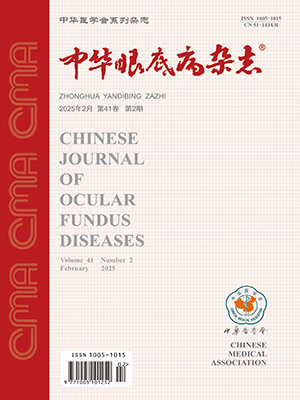| 1. |
Ruiz-Medrano J, Montero JA, Flores-Moreno I, et al. Myopic maculopathy: current status and proposal for a new classification and grading system (ATN)[J]. Prog Retin Eye Res, 2019, 69: 80-115. DOI: 10.1016/j.preteyeres.2018.10.005.
|
| 2. |
Ohno-Matsui K, Wu PC, Yamashiro K, et al. IMI pathologic myopia[J/OL]. Invest Ophthalmol Vis Sci, 2021, 62(5): 5[2021-06-01]. https://pubmed.ncbi.nlm.nih.gov/33909033/. DOI: 10.1167/iovs.62.5.5.
|
| 3. |
Kadonosono K, Yazama F, Itoh N, et al. Treatment of retinal detachment resulting from myopic macular hole with internal limiting membrane removal[J]. Am J Ophthalmol, 2001, 131(2): 203-207. DOI: 10.1016/s0002-9394(00)00728-5.
|
| 4. |
Kuriyama S, Hayashi H, Jingami Y, et al. Efficacy of inverted internal limiting membrane flap technique for the treatment of macular hole in high myopia[J]. Am J Ophthalmol, 2013, 156(1): 125-131. DOI: 10.1016/j.ajo.2013.02.014.
|
| 5. |
Wakabayashi T, Ikuno Y, Shiraki N, et al. Inverted internal limiting membrane insertion versus standard internal limiting membrane peeling for macular hole retinal detachment in high myopia: one-year study[J]. Graefe's Arch Clin Exp Ophthalmol, 2018, 256(8): 1387-1393. DOI: 10.1007/s00417-018-4046-1.
|
| 6. |
Ikuno Y, Sayanagi K, Soga K, et al. Foveal anatomical status and surgical results in vitrectomy for myopic foveoschisis[J]. Jpn J Ophthalmol, 2008, 52(4): 269-276. DOI: 10.1007/s10384-008-0544-8.
|
| 7. |
Alkabes M, Mateo C. Macular buckle technique in myopic traction maculopathy: a 16-year review of the literature and a comparison with vitreous surgery[J]. Graefe's Arch Clin Exp Ophthalmol, 2018, 256(5): 863-877. DOI: 10.1007/s00417-018-3947-3.
|
| 8. |
Liu B, Chen S, Li Y, et al. Comparison of macular buckling and vitrectomy for the treatment of macular schisis and associated macular detachment in high myopia: a randomized clinical trial[J/OL]. Acta Ophthalmol, 2020, 98(3): e266-e272[2019-11-17]. https://pubmed.ncbi.nlm.nih.gov/31736279/. DOI: 10.1111/aos.14260.
|
| 9. |
Zhao X, Li Y, Ma W, et al. Macular buckling versus vitrectomy on macular hole associated macular detachment in eyes with high myopia: a randomised trial[J]. Br J Ophthalmol, 2022, 106(4): 582-586. DOI: 10.1136/bjophthalmol-2020-317800.
|
| 10. |
Qi Y, Duan AL, You QS, et al. Posterior scleral reinforcement and vitrectomy for myopic foveoschisis in extreme myopia[J]. Retina, 2015, 35(2): 351-357. DOI: 10.1097/IAE.0000000000000313.
|
| 11. |
Ando F, Ohba N, Touura K, et al. Anatomical and visual outcomes after episcleral macular buckling compared with those after pars plana vitrectomy for retinal detachment caused by macular hole in highly myopic eyes[J]. Retina, 2007, 27(1): 37-44. DOI: 10.1097/01.iae.0000256660.48993.9e.
|
| 12. |
Ripandelli G, Coppé AM, Fedeli R, et al. Evaluation of primary surgical procedures for retinal detachment with macular hole in highly myopic eyes: a randomized comparison of vitrectomy versus posterior episcleral buckling surgery[J]. Ophthalmology, 2001, 108(12): 2258-2264. DOI: 10.1016/s0161-6420(01)00861-2.
|
| 13. |
Ando F. Use of a special maculae explant in surgery for retinal detachment in macular hole[J]. Jpn J Ophthalmol, 1980, 24: 29-34.
|
| 14. |
Devin F, Tsui I, Morin B, et al. T-shaped scleral buckle for macular detachments in high myopes[J]. Retina, 2011, 31(1): 177-180. DOI: 10.1097/IAE.0b013e3181fc7e73.
|
| 15. |
Stirpe M, Ripandelli G, Rossi T, et al. A new adjustable macular buckle designed for highly myopic eyes[J]. Retina, 2012, 32(7): 1424-1427. DOI: 10.1097/IAE.0b013e3182550648.
|
| 16. |
Parolini B, Frisina R, Pinackatt S, et al. A new L-shaped design of macular buckle to support a posterior staphyloma in high myopia[J]. Retina, 2013, 33(7): 1466-1470. DOI: 10.1097/IAE.0b013e31828e69ea.
|
| 17. |
Zhao X, Ma W, Lian P, et al. Three-year outcomes of macular buckling for macular holes and foveoschisis in highly myopic eyes[J/OL]. Acta Ophthalmol, 2020, 98(4): e470-e478[2019-11-19]. https://pubmed.ncbi.nlm.nih.gov/31742899/. DOI: 10.1111/aos.14305.
|
| 18. |
Theodossiadis GP, Theodossiadis PG. The macular buckling procedure in the treatment of retinal detachment in highly myopic eyes with macular hole and posterior staphyloma: mean follow-up of 15 years[J]. Retina, 2005, 25(3): 285-289. DOI: 10.1097/00006982-200504000-00006.
|
| 19. |
Suda K, Hangai M, Yoshimura N. Axial length and outcomes of macular hole surgery assessed by spectral-domain optical coherence tomography[J]. Am J Ophthalmol, 2011, 151(1): 118-127. DOI: 10.1016/j.ajo.2010.07.007.
|
| 20. |
Wu TT, Kung YH. Comparison of anatomical and visual outcomes of macular hole surgery in patients with high myopia vs. non-high myopia: a case-control study using optical coherence tomography[J]. Graefe's Arch Clin Exp Ophthalmol, 2012, 250(3): 327-331. DOI: 10.1007/s00417-011-1821-7.
|
| 21. |
Nadal J, Verdaguer P, Canut MI. Treatment of retinal detachment secondary to macular hole in high myopia: vitrectomy with dissection of the inner limiting membrane to the edge of the staphyloma and long-term tamponade[J]. Retina, 2012, 32(8): 1525-1530. DOI: 10.1097/IAE.0b013e3182411cb8.
|
| 22. |
Essex RW, Kingston ZS, Moreno-Betancur M, et al. The effect of postoperative face-down positioning and of long-versus short-acting gas in macular hole surgery: results of a registry-based study[J]. Ophthalmology, 2016, 123(5): 1129-1136. DOI: 10.1016/j.ophtha.2015.12.039.
|
| 23. |
Ezra E, Gregor ZJ, Morfields Macular Hole Study Group. Surgery for idiopathic full-thickness macular hole: two-year results of a randomized clinical trial comparing naturalhistory, vitrectomy, and vitrectomy plus autologous serum: moorfields macularhole study group report no. 1[J]. Arch Ophthalmol Chic, 2004, 122(2): 224-236. DOI: 10.1001/archopht.122.2.224.
|
| 24. |
Chen L, Wei Y, Zhou X, et al. Morphologic, biomechanical, and compositional features of the internal limiting membrane in pathologic myopic foveoschisis[J]. Invest Ophth Vis Sci, 2018, 59(13): 5569-5578. DOI: 10.1167/iovs.18-24676.
|
| 25. |
Yokota R, Hirakata A, Hayashi N, et al. Ultrastructural analyses of internal limiting membrane excised from highly myopic eyes with myopic traction maculopathy[J]. Jpn J Ophthalmol, 2018, 62(1): 84-91. DOI: 10.1007/s10384-017-0542-9.
|
| 26. |
Tornambe PE. Macular hole genesis: the hydration theory[J]. Retina, 2003, 23(3): 421-424. DOI: 10.1097/00006982-200306000-00028.
|
| 27. |
Tang N, Zhao X, Chen J, et al. Changes in the choroidal thickness after macular buckling in highly myopic eyes[J]. Retina, 2021, 41(9): 1858-1866. DOI: 10.1097/IAE.0000000000003125.
|
| 28. |
Grossniklaus HE, Green WR. Choroidal neovascularization[J]. Am J Ophthalmol, 2004, 137(3): 496-503. DOI: 10.1016/j.ajo.2003.09.042.
|




